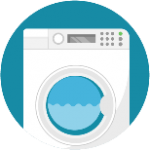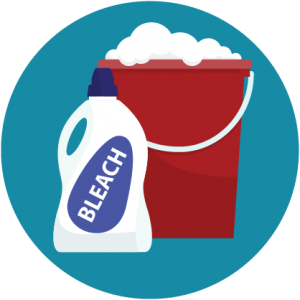Do You Need Face Coverings, Hand Sanitizer, Gloves, or Sanitizing Spray?
Facilities Services manages requests for supplies such as face coverings, hand sanitizer, gloves, or sanitizing spray. Unit business managers can request supplies for their area.
Overview
- General information about face coverings
- Wear your face covering correctly
- Face coverings in the laboratory
- How to wash cloth face coverings
General information about face coverings
- Face coverings are an additional step to help slow the spread of COVID-19 when combined with every day preventive actions and social distancing in public settings.
- You should not wear a face covering if you have trouble breathing, are unconscious, incapacitated or otherwise unable to remove the mask without assistance.
- Safety glasses tend to get foggy from respirations when worn in combination with a face covering. Consider using anti-fogging spray on safety glasses.
- Provide clean storage options for reusable face coverings.
Wear your face covering correctly
Two types of face covers
- Disposable non-medical masks
- Cloth masks
Putting on your face cover
- Wash your hands before putting on your face covering
- Put it over your nose and mouth and secure it under your chin
- Try to fit it snugly against the sides of your face
- It should be loose fitting but still secure enough to stay in place.
- Make sure you can talk with your mask on and that it doesn’t irritate you, so you are not tempted to touch it or pull it out of place
- Make sure you can breathe easily
Taking off your face cover
- Untie the strings behind your head or stretch the ear loops
- Handle only by the ear loops or ties
- Fold outside corners together
- Place covering in the washing machine (learn more about how to wash cloth face coverings)
- Be careful not to touch your eyes, nose, and mouth when removing and wash hands immediately after removing.
Face covers in the laboratory
Disposable Non-Medical face coverings
- Use disposable face coverings in the laboratory work area unless there is a direct safety hazard or chemical incompatibility issue associated with wearing one. Consult with your supervisor/PI if use of your face covering presents safety concerns relative to conducting your job duties.
- A disposable face covering does not replace any other recommended or required personal protective equipment (PPE) for your duties or work space such as goggles, face shields, or respirators, and it should not interfere with the fit or function of PPE.
- Adjust your face covering and ensure it fits properly, so that it does not obstruct your vision. Twist or cross ear-loops to tighten the face covering, if needed.
- Do not touch your face covering with gloved hands. Remove your gloves before taking your face covering off.
- Face coverings should be removed prior to exiting the lab, to minimize the potential for cross-contamination outside of the laboratory.
- Students and staff who conduct research at the laboratory bench/fume hood/biosafety cabinet with hazardous chemicals, biohazards or radioactive materials must discard the disposable face covering at the end of each work shift. If any hazardous materials contact the face covering, it must be disposed of immediately and replaced with a clean covering.
- Disposable face coverings must only be worn for one day and then must be placed in the trash.
- Discard and replace disposable coverings if they become damaged, soiled, or wet.
Cloth face coverings
- Please review the CDC guidance for appropriate use and types of cloth face coverings: CDC Use of Cloth Face Coverings to Help Slow the Spread of COVID-19
- Cloth face coverings are not appropriate in some work environments. They cannot be adequately decontaminated, and therefore should not be worn in environments where the face covering may become contaminated by infectious materials or other hazardous substances.
- Students and staff should not wear a reusable face covering when conducting research at the laboratory bench/fume hood/biosafety cabinet with hazardous chemicals, biohazards or radioactive materials.
- Do not wear a cloth face covering if it can become entangled in machinery.
- Do not wear a cloth face covering when using open flames or flammable materials.
Other Considerations
- Work with your PI/lab group to develop standard operating procedures (SOP’s) to help guide lab members regarding new practices in the laboratory. The EHS Laboratory Safety Services team is available for consultation, and can be contacted at ehs_labsafety@utk.edu.
- There are specialty face coverings available that are flame resistant or that have goggles integrated into the assembly. Specialty face coverings are the department’s/unit’s responsibility to purchase. Two examples are:
- Flame resistant (FR) face masks and arc rated face masks are available (example https://www.safetysupplyamerica.com/category/2545/flame-resistant/fr-face-masks)
- There are face covers with an ANSI approved goggles assembly available (example grainger.com/mobile/product/… ).
How to launder cloth face coverings
- Do not attempt to clean disposable face coverings. These items should be discarded daily.
- Cloth face coverings should be washed after each use. It is important to always remove face coverings correctly and wash your hands after handling or touching a used face covering.
- Washing machine

- You can include your face covering with your regular laundry.
- Use regular laundry detergent and the warmest appropriate water setting for the cloth used to make the face covering
- Washing by hand

- Prepare a bleach solution by mixing:
- 5 tablespoons (1/3rd cup) household bleach per gallon of room temperature water or
- 4 teaspoons household bleach per quart of room temperature water
- Check the label to see if your bleach is intended for disinfection. Some bleach products, such as those designed for safe use on colored clothing, may not be suitable for disinfection. Ensure the bleach product is not past its expiration date. Never mix household bleach with ammonia or any other cleanser.
- Soak the face covering in the bleach solution for 5 minutes.
- Rinse thoroughly with cool or room temperature water.
- Prepare a bleach solution by mixing:
- Washing machine
-
- Drying

- Drying
-
-
- Dryer – Use the highest heat setting and leave in the dryer until completely dry.
- Air dry – Lay flat and allow to completely dry. If possible, place the cloth face covering in direct sunlight.

- Be sure to completely dry cloth face covering after washing to prevent skin irritation.
-
-
- Store clean reusable face coverings in a sealable plastic bag or paper bag with your name written on it.